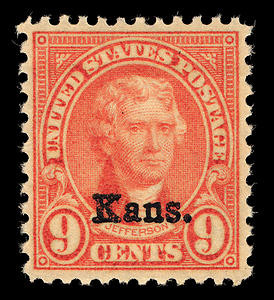

Indeed, the United States has only two overprinted issues on its regularly issued postage stamps-the Kansas-Nebraska issue of 1929, caused by a series of Post Office thefts, and the 1919 Shanghai overprints issued for the US post office in China. Both overprints had political and economic causes. The Kansas-Nebraska issue (Scott#658-679) was issued as the result of a series of post office thefts in those two states in 1929. The theory behind the overprints was that large mailers would be encouraged (but not required) to use overprinted stamps on their mail and so shrink the market for the stolen stamps. It has never seemed to me that this was well thought out as it would be easy to transport the stolen stamps out of state and use them elsewhere. In a paradox that is worthy of these issues, the one issue created because of theft is also the most forged of US stamps. Most forgeries have two gum breaker lines on the back of the stamps instead of one and are easily told by professionals but still some care is required. And the Shanghais (Scott #K1-18) were issued to solidify US political claims in China vis-a-vis other Western powers. There was no real need for them. The United States had long maintained a postal presence in China and US regular issue postage stamps were often used from there. There are no convincing forgeries of US Offices in China and, for the money, they are one of the most interesting sub specialties of US philately.
